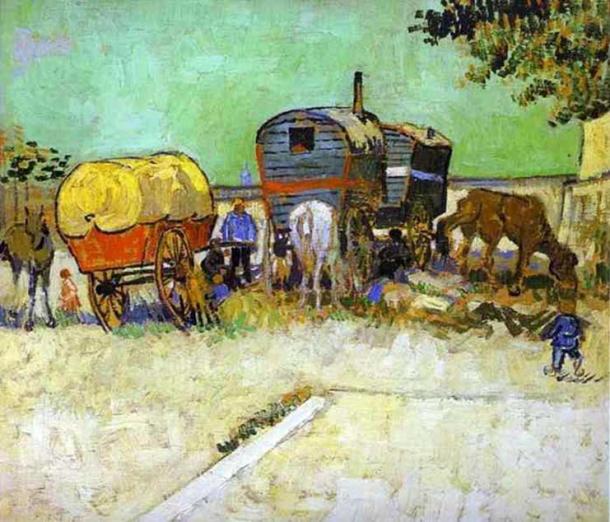Colloquially, and rather insultingly, known as ‘gypsies’, the history and culture of the Romani people is surrounded by stereotypes and misnomers, none more damningly pervasive than Esméralda from the Hunchback of Notre Dame . Because of such images spread by mass media’s misunderstandings of the Romani, it is often believed that the Romani people are to be feared or exiled and avoided.

La Esmeralda. Illustration for Notre Dame de Paris by Victor Hugo. Artist unknown. Appears in “Victor Hugo and His Time” by Alfred Barbou. 1882. ( Public Domain )
The Romani are often painted as thieves and tricksters, in particular because of their nomadic lifestyle and their unorthodox practices in the eyes of the Christian Church during their early migrations. However, the migratory history of the Romani, their cultural persecutions , their native traditions, and their unbreakable familial bonds are likely why they remain so interesting to outsiders today.

‘Spanish Gypsies.’ Source: Public Domain
From “Romani People” to “Gypsy”
So who are the Romani people? From where did they originate, and where have they been?
Recent scholarship has shown the Romani culture has Indian roots. Ronald Lee’s research suggests that North-Central India is their original homeland, although today many dwell in Europe—Italy, Spain, and Eastern Europe in particular— linguistic and genetic specialists are able to point rather confidently to Indian Romani origins.
This likely origin point should not, however, imply that all Romani people are alike; as in every culture, there are definitive distinctions recognized among the Romani. Influenced by their various movements, the collective ‘Romani’ have become individualized groups among themselves. Just as all Native Americans , for instance, are Native American but no two tribes are exactly alike.
The Romani seem to have migrated from northern India to Persia in the 11th century; from there moving into and populating Europe by the 1400’s. Therefore, there are likely groups of travelers distinguished from the collective ‘Romani’ title by their Persian/Iranian customs, or Italian customs, or Romanian customs, depending on migration choices.

‘The Caravans – Gypsy Camp near Arles’ by Vincent van Gogh. ( Public Domain )
Consistently a nomadic culture, the precise population number in each country over the centuries is nearly impossible to obtain. Census records are only so reliable when counting (or discounting) traveling ethnic groups.
For example, the prevalence of Romani people in Persia and Europe in the 11th and 15th centuries respectively can be predicated as a dramatic increase in Romani populations; but specific numbers both then and now remain mere ballpark figures. The inability to definitively nail down specifics also likely influenced the cultural stereotype of Romani “gypsies” that remains prevalent today.

First arrival of gypsies outside the city of Berne, described as “getoufte heiden” (baptized heathens). ( Public Domain )
What is a Gypsy?
The term ‘gypsy’ has become synonymous with the Romani people in many regions. Loosely, the term describes a traveler of exotic origins, believed to have tricks up his/her sleeves and magical charms at the tips of his/her fingers. Such mistaken beliefs are predicated on the jobs the Romani obtained during their constant travels.
As nomads, their work needed to be able to move with them, or be easily left behind. As such, many “were livestock traders, animal trainers and exhibitors, tinkers (metalsmiths and utensil repairmen), and musicians; the women told fortunes, sold potions, begged and worked as entertainers.”
Selling potions and telling fortunes are often construed as a form of witchcraft, and such career choices certainly appealed to a large group of individuals – or else those options would have been financially useless. However, they also made Romani people targets for persecution.
As such, the Romani name became further shrouded in danger and darkness when the persecution of witches and Jews, and other ‘non-Christian’ cultures spread like wildfire through various parts of Europe. Further, the term “gypsy” came to be used as a derogatory term for the Romani, implying their unorthodox ways (insofar as the Christian Church was concerned).

‘Kartomantka’. ( Public Domain ) Depiction of a Romani fortune-teller in Poland, by Antoni Kozakiewicz, 1884.
Romani Families, Not Gypsies
It is because of such persistent mistrust of the Romani culture that the Romani themselves are not trusting and continue to function as individual groups of kin and extended families. They have laws unto themselves, and chiefs and councils as necessary, remaining with a preference for their own rather than those of the non-Romani world.
While this observation is not absolute and should not be applied to all Romani groups or individuals, it does remain a significant aspect of many lives. Although urbanization has thrown a wrench in the traditional rural customs of many Romani factions, one thing has reigned supreme throughout all their migrations: family.

A Gipsy Family. Facsimile of a Woodcut in the “Cosmographie Universelle” of Munster: in folio, Basle, 1552. ( Public Domain )
Traditions have long been passed down through the family, more often orally than written, including native music, systems of justice, and marriage customs. Throughout the years of persecutions and exile, and in spite of the continuous insults from one century to the next, the Romani people have remained a tight knit community of families.

‘Gipsy Children’ by August von Pettenkofen. ( Public Domain )
Whether Italian, Romanian, Russian, Scandinavian, or in American groups, the power of the family is paramount to the continued survival of Romani people’s culture. It is unfortunate that despite the years and actions showing otherwise, the primary image of this group largely remains one of ‘tricksters’ and ‘gypsies’, rather than families.

Postcard of group of Romani people in front of their tent in Smyrne. ( Public Domain )
Top Image: ‘Young Gypsies’ (1879) by William-Adolphe Bouguereau. Family is paramount to the survival of the Romani people’s culture. Source: Public Domain
Updated on January 6, 2021.
Related posts:
Views: 8
 RSS Feed
RSS Feed

















 January 7th, 2021
January 7th, 2021  Awake Goy
Awake Goy  Posted in
Posted in  Tags:
Tags: 
















